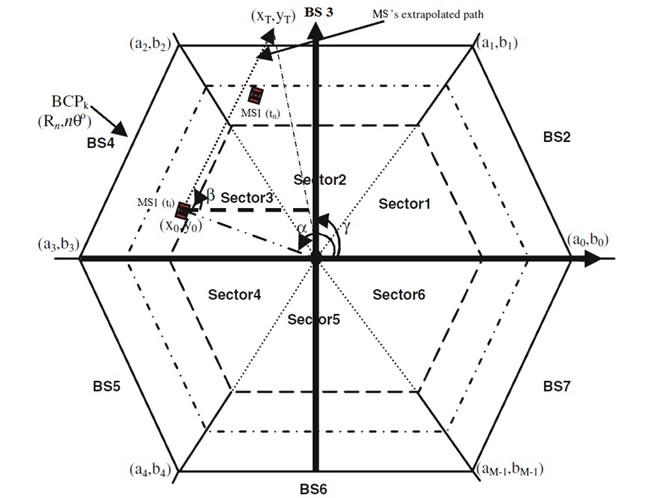|
|
|
Bandwidth Reservation Scheme in GSM
The algorithm presented in this section assigns the prediction responsibility to the BS instead of delegating the prediction responsibility to individual MSs. This reduces the computational power requirement at the MSs, which could be more attractive since battery power limitation and component cost are major concerns for mobile device manufacturers. Also, the BS should be able to handle this additional computational requirement without any difficulty. For every active MS in the cell, the BS performs a series of calculations as α (azimuth of MS’s position from BS where 0◦ ≤ α < 360◦), β (azimuth of MS’s estimated direction of travel, where 0◦ ≤ β < 360◦) and γ (azimuth of MS’s projected position from BS at time Ω, where 0◦ ≤ γ < 360◦). Specifically, a line segment is extrapolated from the MS’s current location in its estimated direction of travel by a distance equal to the product of Ω and the MS’s current speed (refer Fig. 2). This represents the path that would be travelled by the MS if it were to maintain its current speed and direction. The line segment is to be tested for any intersection with the Boundary Cell Points (BCPs).

If an intersection is found, the BCPs that contain this intersection point is determined, which is referred to as the sector while the corresponding target handoff cell is predicted to be the T cell associated with the sector. When the base station detects that a MS has entered the Reservation Zone (RZ) and Handoff Zone (HZ) (by comparing its RSS with certain thresholds) in view of reducing computation and signaling overhead. In the proposed scheme, the bandwidth reservation decisions are based on the current position and extrapolation of the direction MS in the same sector. To illustrate the mobility prediction of the proposed scheme, we compare the scheme with the location scheme which depends on closer distance of MS to BSs. The prediction depends on the projected path that the MS is heading which is called location and direction scheme. Fig.2 show example of when a reservation and a cancellation may occur for the different schemes. Suppose at ti, the MS is in RZ in BS1 and it is close to BS4. As a result, the BS1 sends a reservation request to BS4 on behalf of MS while at ti, the MS is in RZ in BS1 and it is extrapolation of the direction MS to BS3. As a result, the BS1 sends a reservation request to BS3 on behalf of MS. The proposed scheme, BS1 will not send a reservation request because the current position of MS is in sector 3 while the extrapolation of the direction MS is in another sector.
It is assumed that at a later time tn, the BS1 will detect the Ms is closer to BS3. Thus the BS1 needs to send a cancellation to the BS4, as well to a new reservation request to BS3. That is information of MS changes. However, for other schemes earlier reservation request is sent. Based on this example the waste of bandwidth reservation caused by a false reservation or earlier reservation is evident. In this research, the reductions of these limitations are reduced by the defining current position and extrapolation of the MS direction with zones and sectors as integral factors in reservations. Thus, reducing false reservation by a substantial amount observed from the simulation conducted [12].